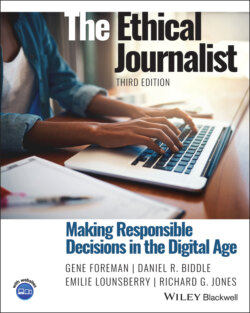Читать книгу The Ethical Journalist - Gene Foreman - Страница 49
Notes
Оглавление1 1 Gloria Cooper, “Laurel,” Columbia Journalism Review, Nov.–Dec. 2001.
2 2 Cathy Trost and Alicia C. Shepard for the Newseum, Running Toward Danger: Stories behind the Breaking News of 9/11 (Lanham, MD: Rowman & Littlefield, 2002), ix–xiii.
3 3 Bill Kovach and Tom Rosenstiel, The Elements of Journalism: What Newspeople Should Know and the Public Should Expect, 3rd edn. (New York: Three Rivers Press, 2014), 22.
4 4 Ibid., 17.
5 5 Leonard Downie Jr. and Robert G. Kaiser, The News About the News: American Journalism in Peril (New York: Alfred A. Knopf, 2002), 6.
6 6 Kovach and Rosenstiel, The Elements of Journalism, 49–56.
7 7 Ibid., 72–77.
8 8 Ibid., 98.
9 9 Ibid., 142.
10 10 Ibid., 171–175.
11 11 Ibid., 197–201.
12 12 David Shatz, Chaim I. Waxman, and Nathan J. Diament (eds.), Tikkun Olam: Social Responsibility in Jewish Thought and Law (Lanham, MD: Jason Aronson, 1997).
13 13 Conrad C. Fink, Media Ethics: In the Newsroom and Beyond (New York: McGraw-Hill, 1998), 246–247.
14 14 Susan E. Tifft and Alex S. Jones, The Trust: The Private and Powerful Family behind The New York Times (London: Little, Brown, 1999), xix.
15 15 Downie and Kaiser, The News about the News, 13.
16 16 W. David Sloan and L.M. Parcell (eds.), American Journalism: History, Principles and Practices (Jefferson, NC: McFarland, 2002), 46.
17 17 “History of the Missouri School of Journalism,” Mizzou: University of Missouri, http://www.missouri.edu/about/history/journalism. php, accessed Jan. 15, 2015.
18 18 Harvey Saalberg, “The Canons of Journalism: a 50-year perspective,” Journalism & Mass Communication Quarterly, an article first published Dec. 1, 1973.
19 19 Cassandra Tate, “What do ombudsmen do?” Columbia Journalism Review, May–June 1984.Tate’s article cited “a 1916 issue of American Magazine.” The reporter’s response was quoted by Kovach and Rosenstiel in The Elements of Journalism, 52–53.
20 20 Paul E. Steiger, “Read all about it,” The Wall Street Journal, Dec. 29, 2007.
21 21 Jack Fuller, News Values (Chicago: University of Chicago Press, 1996), 45–46.
22 22 Neil Henry, American Carnival: Journalism under Siege in an Age of New Media (Berkeley: University of California Press, 2007), 76.
23 23 Robert J. Lifton and Greg Mitchell, Hiroshima in America: Fifty Years of Denial (New York: Putnam, 1995), 10–22, 51–52.
24 24 The Pulitzer Prizes, https://www.pulitzer.org/prize-winners-by-year/1946, accessed Nov. 2, 2020.
25 25 Patrick Reusse, “Star Tribune sports columnist Sid Hartman dies at age 100,” The Star Tribune, Oct. 19, 2020.
26 26 NBA.com, “Sid Hartman and the Minneapolis Lakers,” June 20, 2011. Accessed on Nov. 2, 2020, at: https://www.nba.com/lakers/news/110228sidhartman.html.
27 27 Steven K. Knowlton and Patrick Parsons, The Journalist’s Moral Compass (Westport, CT: Praeger, 1995), 207–208.
28 28 Commission on Freedom of the Press, A Free and Responsible Press: A General Report on Mass Communication: Newspapers, Radio, Motion Pictures, Magazines, and Books (Chicago: University of Chicago Press, 1947), 20–30.
29 29 George Sokolsky, “Dumb professors,” essay included in a collection of reaction to the Hutchins Report, Nieman Reports, July 1947, 18.
30 30 Charlene J. Brown, Trevor R. Brown, and William L. Rivers, The Media and the People (Huntington, NY: R. E. Krieger, 1978), 178.
31 31 A. David Gordon and John Michael Kittross, Controversies in Media Ethics, 2nd edn. (New York: Longman, 1999), 97.
32 32 Frederick S. Siebert, Theodore Peterson, and Wilbur Schramm, Four Theories of the Press (Urbana: University of Illinois Press, 1956).
33 33 Karen Schneider and Marc Gunther, “Those news-room ethics codes,” Columbia Journalism Review, July–Aug. 1985. Through his work in the Associated Press Managing Editors, Gene Foreman also observed the exponential growth of newsroom codes in the 1970s and 1980s.
34 34 Michael Josephson, Making Ethical Decisions (Los Angeles: Josephson Institute, 2002), 29.
35 35 Mark A. Nelson, “Newspaper ethics code and the NLRB,” Freedom of Information Center Report No. 353, Columbia, MO.
36 36 George N. Gill, “It’s your move, publishers,” Quill, Aug. 1973.
37 37 Poorman was quoted in “Junketing journalists,” Time, Jan. 28, 1974.
38 38 Schneider and Gunther, “Those newsroom ethics codes”.
39 39 Gene Foreman is indebted to the following for their insights into the reasons for increased ethical awareness: John Carroll, Bob Giles, Bill Marimow, Jim Naughton, Mike Pride, Steve Seplow, and Bob Steele.
40 40 Roy Peter Clark, “Red light, green light: a plea for balance in media ethics,” Poynter, May 17, 2005.
41 41 Alicia C. Shepard, “To err is human, to correct divine,” American Journalism Review, June 1998.
42 42 Wilbert E. Moore, “Is journalism a profession?” in The Professions: Roles and Rules (New York: Russell Sage, 1970), 4–22.
43 43 Lars Willnat and David H. Weaver, The American Journalist in the Digital Age: Key Findings (Bloomington: School of Journalism, Indiana University, 2014), 9. The findings come from online interviews conducted Aug. 7–Dec. 20, 2013, with 1,080 US journalists working in print, broadcast, and online media.
